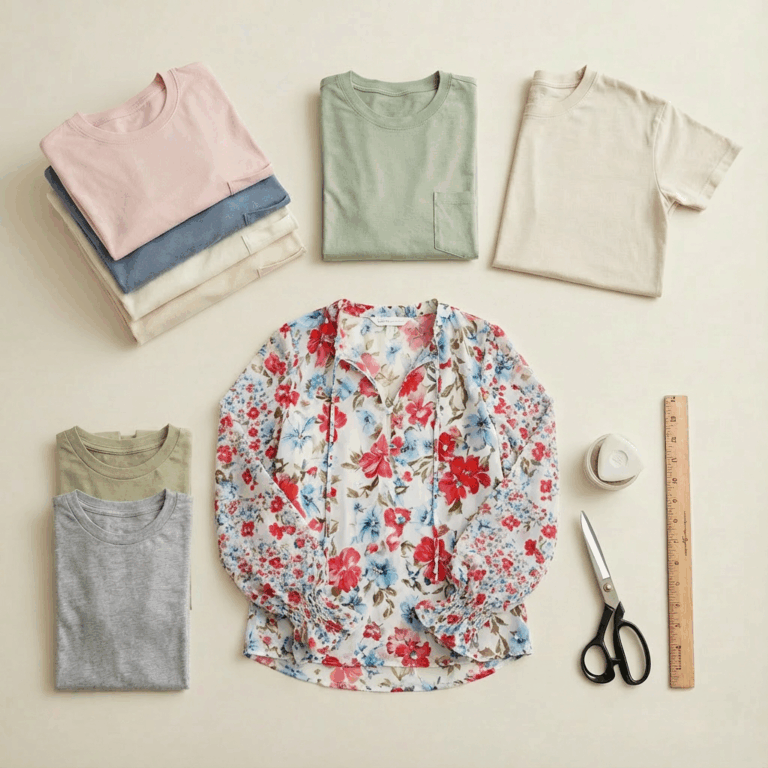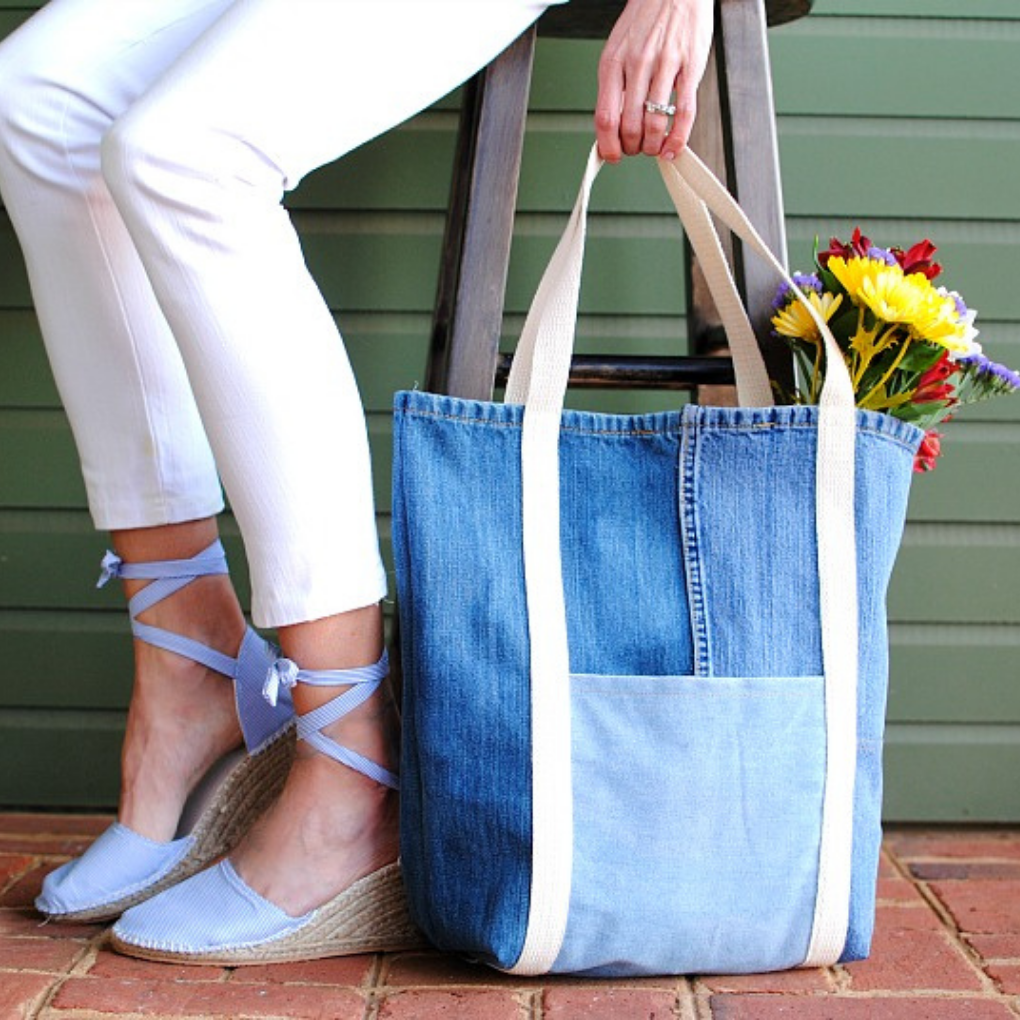
Key Takeaways
- Billions of plastic bags are used every year — most can’t be recycled and often end up polluting the environment.
- Old jeans take decades to break down in landfills, but their strong, durable fabric makes them perfect for upcycling.
- Each handmade bag helps replace countless single-use plastic bags while keeping textiles out of the waste stream.
Jeans are one of the hardest-working staples in our closets. They last for years, but when they finally wear out or stop fitting, most people toss them into the donation pile or, worse, the trash. The problem? Denim takes decades to break down in landfills, and the fashion industry is already one of the world’s most polluting sectors.
Here’s the bright side: old jeans can be given a whole new life. By turning them into reusable denim bags, you’re not only saving fabric from the landfill, but you’re also reducing the use of single-use plastic bags. It’s a win for your wallet, your wardrobe, and the planet.
This guide explores why upcycling matters, how denim bags can replace plastic, and step-by-step tutorials from creators who make it easy for anyone to try.
Why Upcycle Jeans Into Bags?
👖 Denim Is Tough and Timeless
Jeans are made to last. The tightly woven cotton fibers make denim strong enough to carry groceries, books, or even serve as an everyday purse. Instead of letting that durable fabric sit in a landfill, you can turn it into a bag that works as hard as the jeans once did.
🌍 Cut Down on Plastic Pollution
Billions of single-use plastic bags are still consumed every year. According to the United Nations Environment Programme, plastic bags remain one of the top contributors to ocean microplastic pollution. By carrying a reusable denim tote, you skip the plastic entirely and make a direct impact every time you shop.
♻️ Fight Textile Waste
The U.S. alone discards 11 million tons of textiles each year, and globally, the fashion industry generates around 92 million tons of textile waste annually. Denim is a significant contributor, as it is a heavy and resource-intensive product to produce. Repurposing just one pair of jeans into a bag saves an estimated 1,500 gallons of water that would otherwise be needed to make new cotton fabric.
🧵 Support Slow Fashion
Fast fashion promotes disposability, but upcycling counters that system. When you transform old jeans into a bag, you’re embracing the values of slow fashion: creativity, craftsmanship, and conscious consumption. Plus, your denim bag will likely last longer than many store-bought “eco” totes.
💸 Save Money and Resources
DIY upcycling projects aren’t just good for the planet — they’re good for your wallet. A homemade denim bag costs a little more than your time, thread, and maybe a lining fabric if you want to add extra polish. Considering that reusable fabric totes at shops can run $20 or more, making your own is a budget-friendly swap.
✨ Room For Creativity
Old jeans are a blank canvas. A patchwork shopper, a chic clutch, or even a no-sew tote can all start from the same pair of pants. You can add embroidery, paint, or iron-on patches to make each bag feel like wearable art.
A Bigger Picture: Plastic Bag Bans and Global Change
Upcycling jeans into bags isn’t just about DIY fun — it’s part of a much larger movement toward sustainability. Over 90 countries have introduced bans or restrictions on single-use plastic bags, from lightweight grocery sacks to thicker plastic carriers. The European Union has set targets to cut plastic bag consumption by 80%, and cities across the U.S. (like San Francisco and New York) have adopted their own bans or fees.
Despite these efforts, billions of plastic bags are still produced every year. Many escape into the environment, where they break down into microplastics that harm wildlife and contaminate our food chain. By making and using denim bags, you’re not only reducing your personal plastic footprint but also showing that creative, sustainable alternatives are possible.
11 Creative Ways to Upcycle Jeans Into Chic Denim DIY Bags
Earth Day Denim Tote — Trash to Couture
Laura of Trash to Couture has built her brand on the idea of turning trash into couture, and this Earth Day denim tote is the perfect example. Instead of tossing worn-out jeans, she transforms them into a sturdy, reusable bag that’s as stylish as it is sustainable.
The beauty of her approach is that nothing goes to waste — scraps get pieced together into a patchwork design, back pockets become built-in storage, and original hems double as finished edges. Paired with strong cotton webbing straps and bold gold topstitching, the result is a bag that proves eco-friendly fashion can be both practical and elevated.

Tutorial: Trash to Couture
Materials Needed
- Old pair of jeans (or denim scraps)
- Jeans needle
- Gold jeans thread
- 3 yards of cotton webbing (for straps)
- Bias tape (optional for finishing seams)
- General sewing supplies (scissors, pins, ruler, iron)
- (Optional) Serger for finishing seams
Recycled Denim Patch Tote — DIY Joy
Here’s a bag that proves scraps can shine. By piecing together old denim into a patchwork, you get a tote that’s functional and full of personality. No two bags will ever be the same.
The layered construction, with interfacing, batting, and lining, keeps it structured and strong. Add reinforced straps and a magnetic closure, and you’ve got a handmade tote that looks polished enough to carry every day. Love the size too!
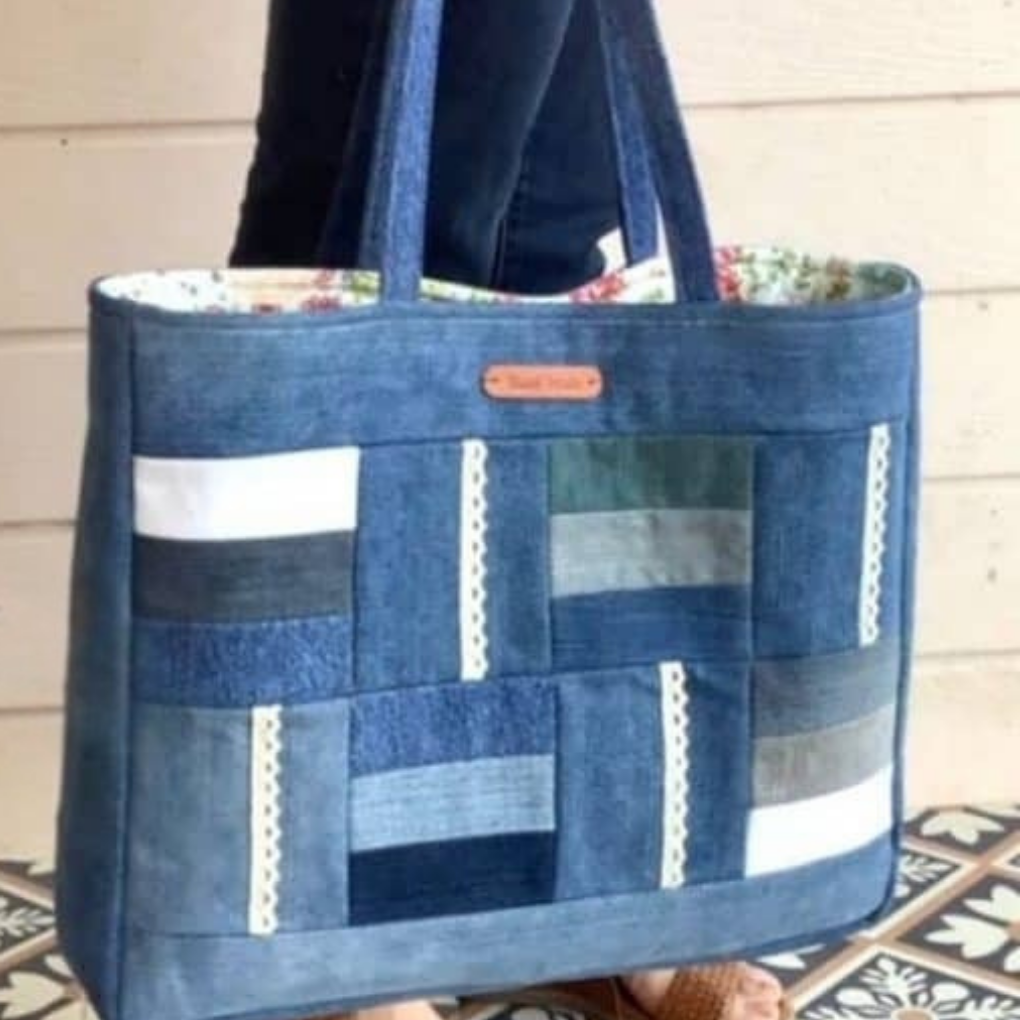
Tutorial: DIY Joy
Materials Needed
- Old pair of jeans (for main panels and base fabric)
- Scrap denim for patch pieces
- Fusible interfacing
- Batting (lightweight)
- Lining fabric
- Straps made from denim (reinforced with interfacing)
- Magnetic button for closure
- Strong sewing thread
- Sewing machine (capable of sewing multiple layers)
- Scissors, pins/clips, ruler, and iron
Kraft-Tex Denim Tote — Nancy’s Notions
Want a tote that feels a little more elevated? This pattern pairs upcycled denim with Kraft-Tex, a paper-like material that sews like fabric but looks like leather. The mix creates a bag that’s sturdy, eco-friendly, and effortlessly stylish.
The combo of denim’s timeless look with Kraft-Tex structure gives the bag both durability and a modern edge. Add interfacing for stability, and the result is a carryall you’ll actually want to show off.
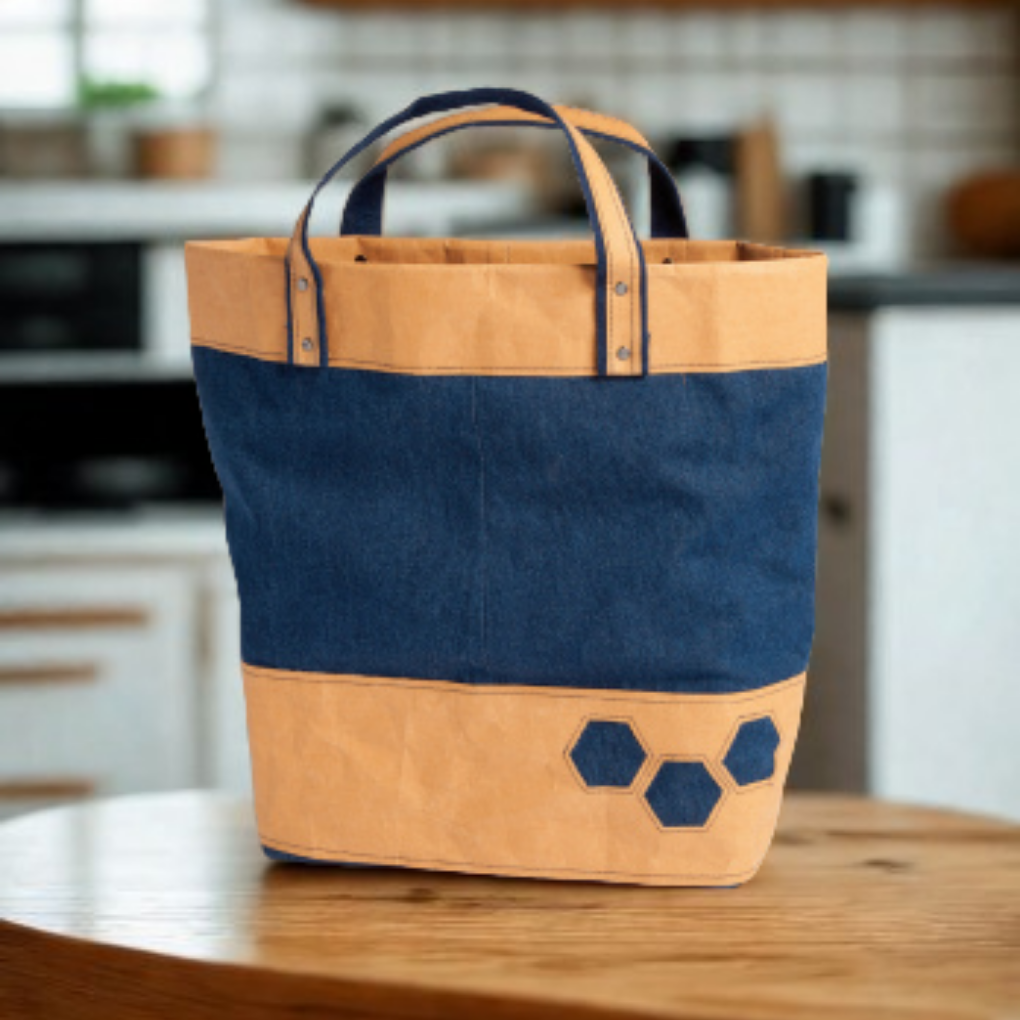
Tutorial: Nancy’s Notions
Materials Needed
- Old pair of jeans (for denim panels)
- Kraft-Tex fabric (for structure and leather-like detail)
- Heavyweight interfacing or stabilizer (for added durability)
- Strong sewing thread
- Sewing machine (capable of handling multiple layers)
- Basic sewing tools: scissors, pins, ruler, chalk or marking tool
Classic Denim Tote — Vicky Myers Creations
This isn’t your average upcycle. Vicky Myers offers a free, full-size pattern for a lined, padded, and finished denim tote, complete with thoughtful details like a snap closure, interior zip pocket, and reinforced handles.
What makes it stand out is its ability to be personalized. Add hand stitching, decorative patches, or experiment with boxed corners and interfacing. It’s the kind of denim bag that feels both practical and beautifully designed.

Tutorial: Vicky Myers Creations
Materials Needed
- Old pair of jeans (or other sturdy denim fabric)
- Additional heavyweight fabric (for base, sides, and handles)
- Fusible fleece or interfacing (to give structure)
- Lining fabric (plus optional fabric for interior zip pockets)
- Zippers (for pockets)
- Magnetic snap closure
- Strong sewing thread and denim needle
Market Tote — Crafting a Green World
Sometimes, simple really is best. This bag is made from just one pair of old jeans, creating a sturdy market tote. It’s casual, laid-back, and ready for grocery runs, farmers’ markets, or everyday errands.
Its charm lies in the no-fuss approach. A little cutting, a little stitching, and you’ve got a rustic bag that’s strong, functional, and perfectly imperfect. It’s the ideal entry point if you’re new to sewing or upcycling.

Tutorial: Crafting a Green World
Materials Needed
- Denim pant legs or denim scrap panels
- Scissors
- Sewing machine (or hand-sewing tools)
- Thread (can use a contrasting color for effect)
- (Optional) decorative elements for finishing, e.g., a brooch or embellishment
Sturdy Denim Bag — Between the Lines
Roomy enough to hold daily essentials yet sleek enough to carry anywhere, this denim tote strikes a balance between durability and elegance. The clean seams and leather handles give it a polished finish without losing the practicality denim provides.
French seams, boxed corners, and reinforced stitching add structure and strength, creating a bag that’s versatile enough for work, errands, or even travel.
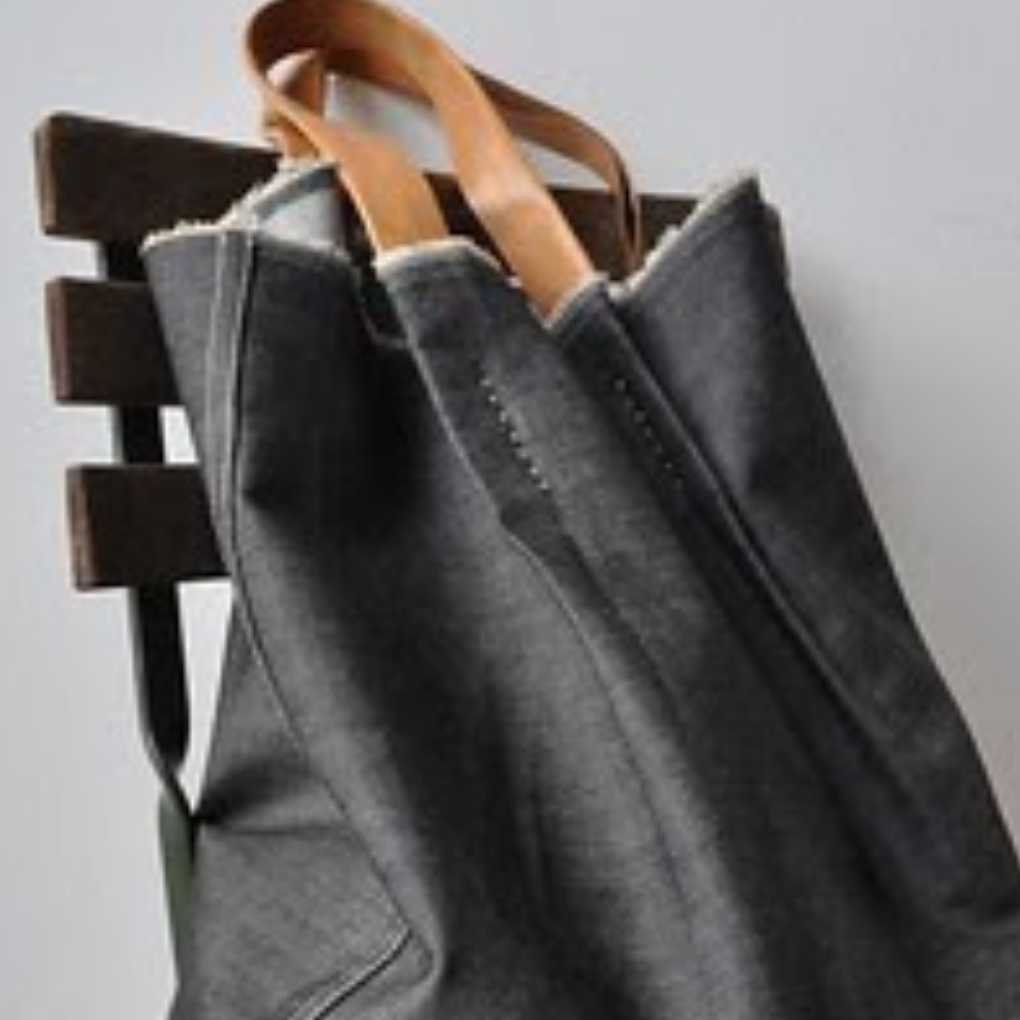
Tutorial: Between the Lines
Materials Needed
- Denim, canvas, or other heavyweight fabric (enough for two 54 × 52 cm pieces)
- Two leather straps (65 × 6 cm each)
- Sewing machine + iron
- Heavy-duty thread and strong needle
- Scissors
- Awl (for making holes in the leather)
- Large paper clips (to hold straps in place)
Patchwork Denim Tote — Free-Tutorial.net
This tutorial leans into patchwork charm. Scraps from different pairs of jeans come together in block patterns that highlight every shade of denim. The visible seams and quilt-like look give it a character that’s unique.
Functionality isn’t sacrificed. With boxed corners for depth, a lining for structure, and webbing straps for strength, the Patch Tote is as reliable as it is creative.
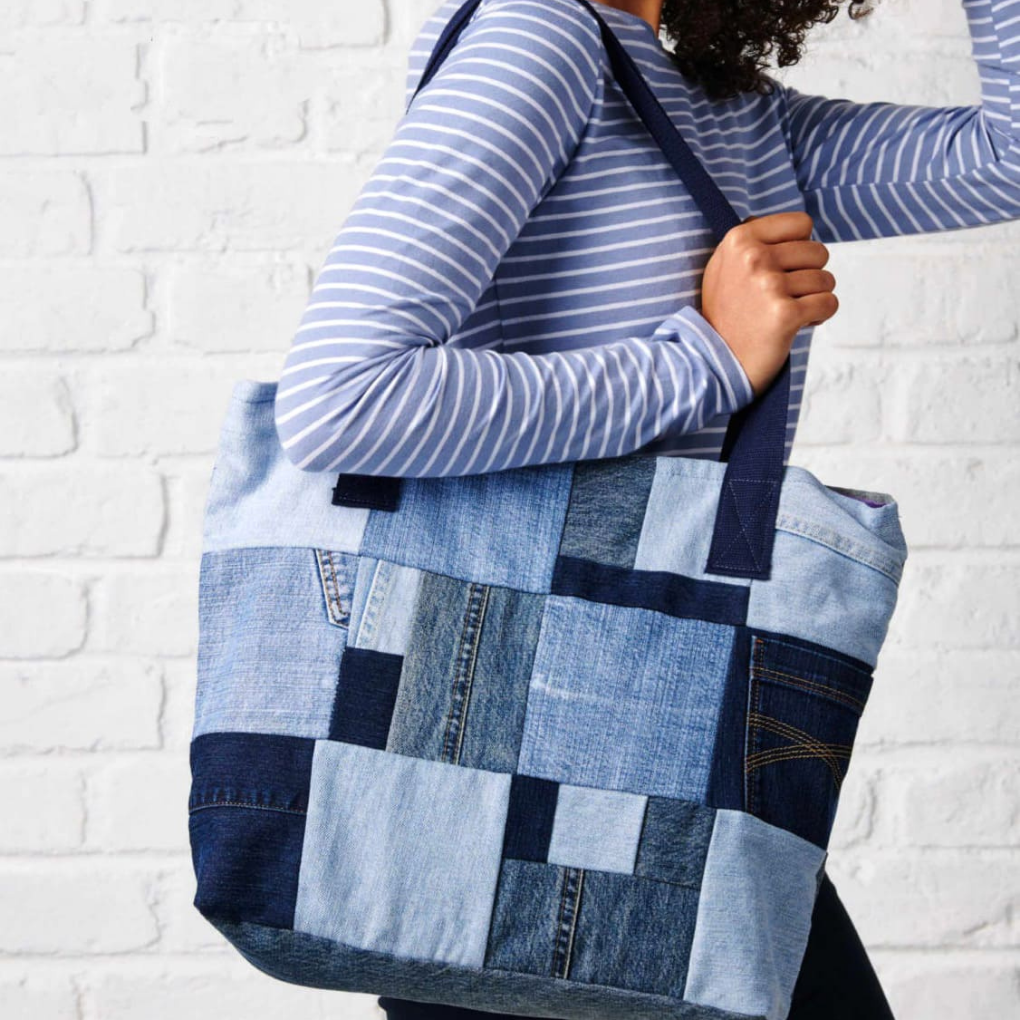
Tutorial: Free-Tutorial.net
Materials Needed
- A few pairs of old jeans (denim fabric for patchwork)
- Lining fabric (approx. 20 × 40 in)
- Webbing straps (~64 in total, 1 5⁄8 in wide)
- Denim sewing machine needle
- Matching thread
- Basic sewing kit (scissors, pins, etc.)
Reverse Seams Tote Bag — Creative Fabrica
Here’s a clever design: the reverse-seam denim tote. By flipping the seams outward, you eliminate raw edges on the inside, which means no lining is required. It’s approachable for beginners, yet still has a polished finish.
With three bag sizes, ranging from a large shopper to an everyday tote, plus add-on pockets and handle variations, this tutorial gives you options. The frayed details add texture, making it both trendy and practical at the same time.

Tutorial: Creative Fabrica
Materials Needed
- Old denim (works best for fraying effect)
- Sewing machine and basic sewing tools (scissors, pins, ruler, thread)
- Pattern printouts (A4 size, provided with the download)
- Handle materials (fabric or alternative straps)
- (Optional) Pocket fabric for customization
Reinforced Denim Tote — Ballen Blogger
Think of this as the bag that proves upcycling can look chic. Using old jeans, you create a sturdy denim tote with wide straps and reinforced corners — perfect for groceries, books, or even your laptop.
The best part is how easily it can be customized.
You can sew your own straps or use cotton webbing, add interfacing for extra polish, or line it with muslin for a professional touch. Simple, sustainable, and stylish.
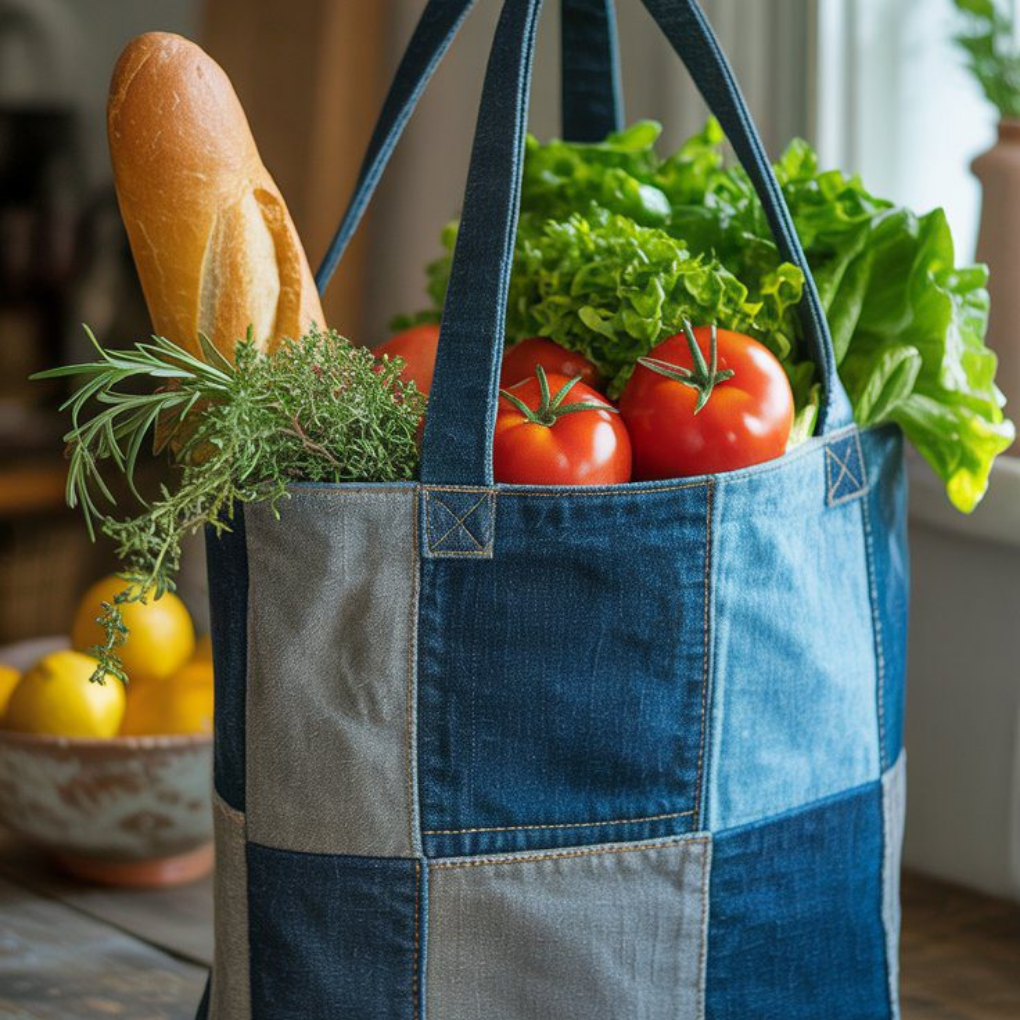
Tutorial: Ballen Blogger
Materials Needed
- 1 pair of old jeans, canvas curtains, or heavyweight cotton scraps
- ½ yard cotton or muslin for lining
- Coordinating thread
- (2) 24″ × 2″ cotton webbing or strap material
- (Optional) ¼ yard fusible interfacing for added strength
- Sewing machine, scissors or rotary cutter, pins/clips, iron
Denim Rope Tote — Handmadiya
If you love coastal style, this one’s for you. The design swaps out standard straps for thick cotton rope threaded through grommets, giving the tote a breezy, nautical vibe. It’s roomy enough for beach days, shopping, or weekend outings.
Bound seams keep everything neat while also adding decorative detail. Paired with the sturdy denim panels and rope handles, the bag feels modern, versatile, and built to last.
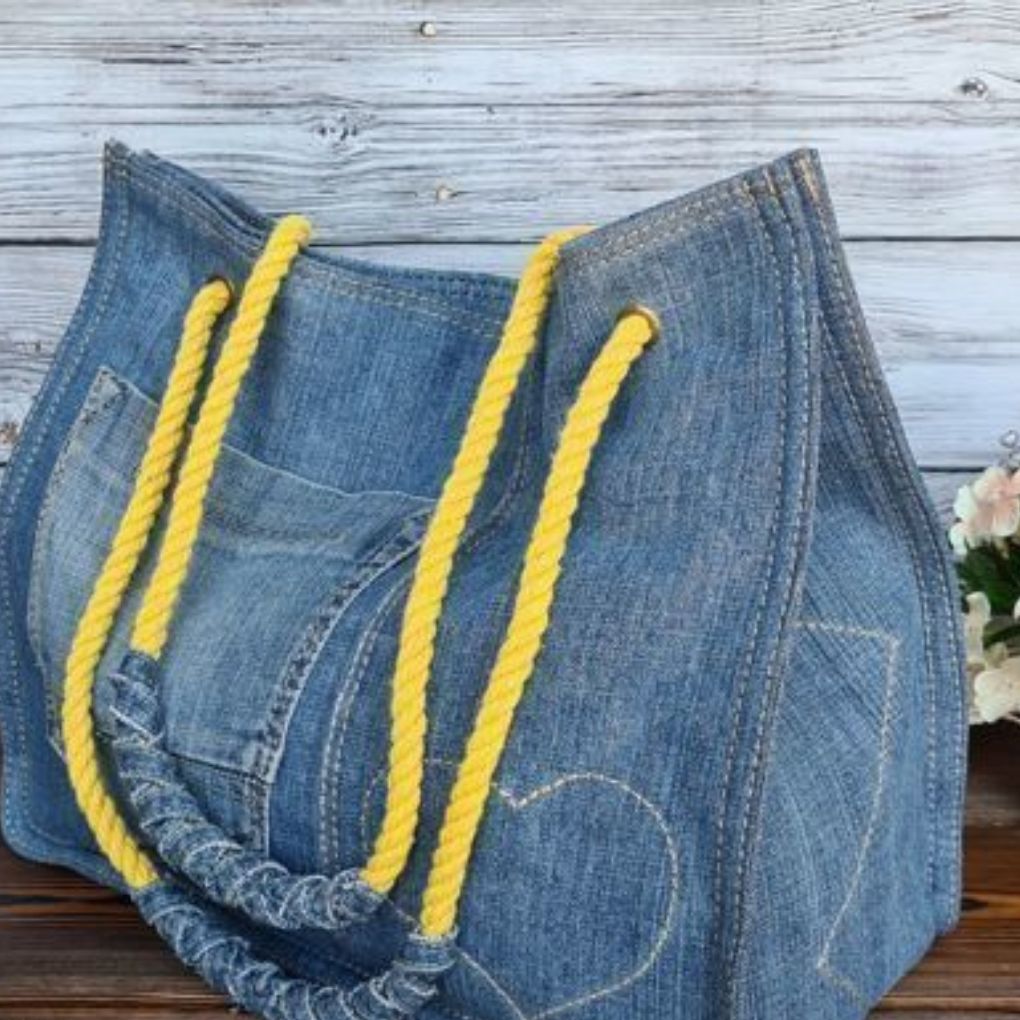
Tutorial: Handmadiya
Materials Needed
- Old pair of tight jeans (similar in color for consistency)
- Cotton rope (6–8 mm diameter)
- Grommets (8 mm, eight pieces)
- Strong sewing thread
- Sewing machine (for medium/heavy fabrics)
- Scissors
- Measuring tape
- Chalk or soap (for marking)
- 6 mm punch hole tool
- Press for installing metal fittings
Drawstring Denim Bag — Sewing Times
This tutorial transforms old jeans into a versatile drawstring bag that’s equal parts casual and chic. It’s easy to cinch shut, lightweight to carry, and perfect for errands, gym gear, or even as a casual day bag.
The design is effective due to its simplicity. Denim’s strength keeps it durable, while the drawstring closure adds both function and flair. It’s a great way to branch out beyond standard totes while still keeping the project approachable.
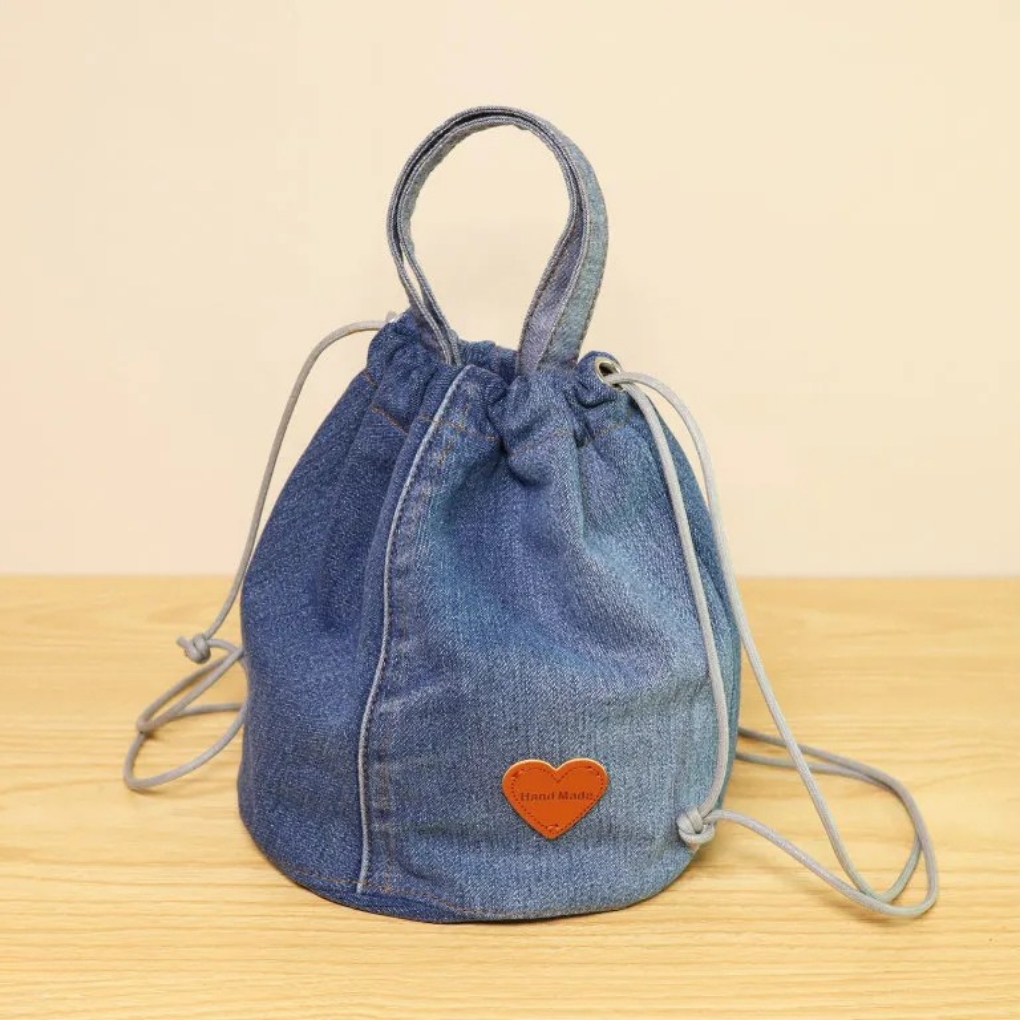
Tutorial: Sewing Times
Materials Needed
- Old jeans (for outer fabric)
- Lining fabric (if the tutorial includes a lining)
- Cord, rope, or strong drawstring material
- Grommets, eyelets, or casing for the drawstring
- Strong thread
- Sewing machine capable of handling multiple layers
- Scissors, pins or clips, ruler, chalk or marking tool
- Optional: interfacing or stabilizer for added structure
Sewing Glossary: Key Terms
- Interfacing: A fabric (often fusible) added to panels to give structure and strength, especially helpful for bag bases and handles.
- Flat-felled seam: A strong, durable seam where raw edges are enclosed. Common in jeans and ideal for bag seams that need reinforcement.
- French seam: A seam technique that hides raw edges inside, giving a neat, finished look on both sides of the fabric.
- Boxed corners: A sewing method that adds depth to the bottom of a bag, allowing it to stand upright and hold more volume.
- Topstitching: A line of stitching on the outside of the fabric that reinforces seams and adds a decorative finish.
✨tips
Sewing and Customizing Your Denim Bags
Making a bag from old jeans is more than just following a pattern; it’s a chance to explore your creativity, stretch your sewing skills, and craft something that reflects your personal style. Here are ways to take your project to the next level:
- Reinforce for strength: Denim is rigid, but bag seams take a lot of strain. Add interfacing to panels or use flat-felled or French seams for a professional finish that prevents fraying and strengthens the bag. Reinforcing stress points, such as the base corners or where handles attach, will help your tote last for years.
- Play with pockets: Jeans come with ready-made storage solutions, so use them. Keep back pockets intact and stitch them onto the front or inside of your bag for built-in compartments. Smaller coin pockets can be repurposed into interior phone or key slots. This not only adds function but also highlights the denim’s character.
- Mix materials for contrast: Don’t be afraid to combine denim with other fabrics. Canvas or linen can give your tote a lighter, summery vibe, while leather or faux leather accents add a touch of polish. A cotton print lining makes the inside pop with color while protecting the seams from wear. Even trims like lace, ribbon, or bias tape can add a unique edge to your bag.
- Add personality through embellishment: Upcycled projects are the perfect canvas for self-expression: Hand-embroider florals, geometric patterns, or even your initials onto the panels. Iron-on patches, fabric paint, or beading can turn a plain tote into a statement piece. If you want a low-effort upgrade, try contrasting thread in gold, red, or white for visible topstitching.
- Think beyond totes: Once you’ve mastered the basic tote, experiment with other styles. A simple pair of jeans legs can be transformed into a drawstring backpack. Patchwork panels can be cut into a clutch or makeup pouch. Waistbands can become straps, and belt loops can serve as holders for keys or carabiners. Each new design challenges you to see denim scraps as building blocks for endless possibilities.
- Sustainable sewing hacks:
- Use denim needles and strong polyester thread to prevent breakage.
- Save leftover scraps for smaller projects, such as coasters, pencil cases, or patch appliqués.
- When piecing panels, overlap seams and topstitch instead of cutting perfectly square blocks, it reduces waste and adds character.
- Wash your finished bag inside out in cold water to preserve color and reduce microfibre shedding.
With a bit of imagination, every pair of jeans can yield more than one project — from a sturdy market tote to accessories that show off your creativity.
How to Care for Your Denim Bag
A handmade denim bag can last for years with the proper care. While denim is usually cotton-based and doesn’t shed as many microplastics as synthetic fabrics, many DIY projects use extras like polyester lining, nylon straps, or synthetic thread. With a few mindful habits, you can extend your bag’s life and keep it as sustainable as possible:
- Wash sparingly. Unlike clothes, bags don’t need frequent laundering. Clean only when necessary to avoid wear and conserve water.
- Spot-clean first. A damp cloth and mild soap can handle most stains without a complete wash. This helps protect fabric, stitching, and shape.
- Use a microfiber filter. If your bag includes synthetic parts, wash it in a Guppyfriend bag or with a washing machine filter to capture microplastics before they enter waterways.
- Choose gentle detergents. Opt for biodegradable, plastic-free laundry powders or liquid refills. Harsh chemicals can weaken fibers and pollute the environment.
- Air-dry naturally. Skip the dryer. Lay your bag flat or hang it in the shade to prevent fading, save energy, and protect handles from heat damage.
- Store smart. When not in use, keep your denim bag in a cool, dry place. Stuff lightly with paper or fabric scraps to help maintain its shape.
With these care steps, your DIY tote won’t just replace plastic bags today — it will stay with you for years to come, proving that sustainable fashion can be both practical and stylish.
Don’t Miss: Plastic-Free Living Guide 👉Ready to go beyond reusable bags? Learn more about why reducing plastic is so important. Read more →FAQs About Denim DIY Bags
Yes! Several no-sew tutorials use cutting, knotting, or fabric glue to shape denim into totes. These projects are perfect for beginners or anyone without access to a sewing machine.
Sturdy denim works best — think heavyweight jeans or those with minimal stretch. Stretchy denim can sag, while classic cotton denim will hold its shape and last longer.
Reinforce seams with interfacing or double stitching, especially at stress points like corners and handle attachments. Flat-felled or French seams also add durability and give a polished finish.
Pure cotton denim sheds far fewer microplastics than synthetic fabrics like polyester. If your bag has polyester lining or nylon straps, use a microfiber filter bag (like Guppyfriend) when washing to capture fibers.
Beyond tote bags, old jeans can be transformed into aprons, cushion covers, storage bins, coasters, or even patchwork quilts. The sturdy fabric makes denim one of the most versatile materials to repurpose.
Final Thoughts on Denim DIY Bags
Upcycling old jeans into bags is more than just a creative sewing project — it’s a meaningful way to cut waste and skip plastic. Every tote, patchwork shopper, or drawstring bag you make keeps denim out of landfills and replaces countless single-use plastic bags.
The beauty of denim is its strength and timeless style. By transforming worn-out jeans into reusable bags, you’re not only extending the life of the fabric but also creating something functional, durable, and uniquely yours. Whether you choose a simple no-sew tote or a more advanced design with boxed corners and grommet handles, there’s a denim bag tutorial to match your skill level and style.
Featured Image: Trash to Couture
📚References
- Environmental Protection Agency. National Overview: Facts and Figures on Materials, Wastes and Recycling. Retrieved from https://www.epa.gov/facts-and-figures-about-materials-waste-and-recycling/national-overview-facts-and-figures-materials
- United Nations Environment Programme. (2025, June 2). Everything you should know about microplastics. United Nations Environment Programme. https://www.unep.org/news-and-stories/story/everything-you-should-know-about-microplastics
- Ellen MacArthur Foundation. (2017). A new textiles economy: Redesigning fashion’s future. https://ellenmacarthurfoundation.org/a-new-textiles-economy
